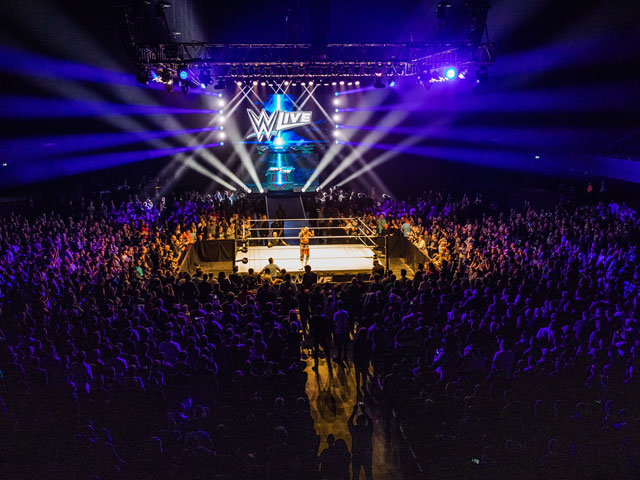Is World Wrestling Entertainment (WWE) Real or Fake?
Wrestling in the WWE is scripted. It was fake when it was the WWF and will continue to be so moving forward. That does not mean that the actors/athletes aren't exceptionally talented.
| Read: 5 min

Whether on Monday Night Raw or at the grandest stage of them all of Wrestlemania, WWE superstars entertain fans across the globe. Professional wrestling, also known as sports entertainment, is watched by millions of people every week. No, it's not one of the most popular sports in the world, despite the viewership.
For years people have wondered “Is WWE fake?” We will look at what makes WWE real and what elements the people behind the scenes script. To note, the same applies to AEW (All Elite Wrestling).
What Is Fake or Scripted?
Professional wrestling as we know it has existed for centuries. It can trace its origins back to traveling circuses and Vaudeville. The WWE first came into existence in 1953 as the Capitol Wrestling Corporation, before later being known as the WWWF and WWF. Wrestling hit its first national boom period in the 1980s with the rise of Hulk Hogan in the main event of WWE pay-per-view tv shows like their Royal Rumble and Wrestlemania.
To put it bluntly: sports entertainment is a scripted event. The outcomes of WWE matches and the rivalries are all predetermined and there is little truth in the storylines presented on the screen. The two wrestlers in the ring are not trying to injure the others, and they often do not share any of the animosity their characters present on the screen.
Put another way, you can think of WWE superstars as actors and stuntmen. They entertain crowds with stunts and storylines on WWE Smackdown but are just reading lines from a script. The crowds respond to the storylines presented on the show as well as the athleticism on display from the performers.
What Proof Exists That WWE Is Scripted?
Perhaps the most conclusive proof comes from the CEO and founder of WWE, Vince McMahon, himself. Since the early 20th century, the legitimacy of wrestling has been a constant question for reporters. But no hard evidence was ever put forward to prove the claims that promoters fixed matches.
In 1989, Vince McMahon flat-out stated that pro wrestling was not a legitimate competition and that the promoters scripted the outcomes. He compared professional wrestlers to athletes at the circus or the Harlem Globetrotters, an athletic display to entertain crowds but not true fighters.
Proof also comes from the matches themselves. Determining the legitimacy of a wrestling match has never been easier than it is today with the rise of high-definition cameras and MMA. Keen viewers can spot moments when WWE wrestlers pull their punches or whiff when trying to make contact for a move. Wrestling fans call these mistakes botches, and they pull back the curtain on the nature of the matches.
Even when the matches are proceeding as planned and both competitors are performing exactly how they want to, wrestling often doesn’t resemble a real fight. MMA fighters never use staples of the WWE superstar’s arsenal like piledrivers and figure-four leglocks. MMA practitioners are legitimate fighters and fight in a way that makes wrestling look very fake.
WWE has never gone to great pains to make its matches look as brutal as MMA. Some wrestling companies in Japan perform “shoot style” matches; these matches more closely resemble MMA fights, with a more grounded offense of strikes and submissions. But these matches are just as scripted as anything you’ll see on Monday Night Raw.
What’s Real About Sports Entertainment?
Now that you know the answer to “Is WWE fake?”, let’s talk about what parts are real. The booker scripts the outcomes and the competitors are not earnestly trying to injure one another, but wrestling is still legitimate in several ways. Injuries happen in wrestling, and the toll on the body can lead to long-term complications and sometimes death.
One wrong move or a one-second mistiming can lead to serious injury. A famous example occurred during a match between Owen Hart and “Stone Cold” Steve Austin in 1996. Hart picked up Austin for the tombstone piledriver, a perfectly safe move when executed properly. But Austin’s head was too low and he broke his neck on the landing.
This injury left Austin unable to wrestle for months and nearly derailed his career. Successful neck surgery got him back on his feet, and he went on to become one of the most famous wrestlers ever. But one mistake nearly cost him his life.
But even when wrestlers execute every move as intended, wrestling still carries with it a sense of long-term danger that can lead to real-life injury. In 1998, the Undertaker and Mankind had a very famous Hell in a Cell match at WWE’s King of the Ring that saw the latter take some serious punishment.
The Undertaker threw Mankind, better known as Mick Foley, from the top of the 16-foot high cell to the announcer’s table on the floor. The spot went off without a hitch, but it seriously injured Foley. He later climbed to the top again, when the Undertaker gave him a chokeslam that sent him through the top of the cell to the ring, which left him with a dislodged tooth and separated shoulder.
Foley finished the match and became a legend for it, but the toll it took on his body was great. Mick Foley is perhaps the most famous example of a wrestler suffering for their art.
Wrestling takes its toll on the body of all its performers, and many wrestlers have had their lives, unfortunately, cut short from accrued injury in the ring.
Mitsuhara Misawa was a Japanese wrestler who many consider the greatest ever. Wrestling fans remember Misawa for the brutal attacks on the neck and head in his matches. Misawa forced himself to wrestle past when his body could handle it, and he took one last bump in 2009, which led him to the hospital and ultimately his death.
While figures like Vince McMahon may script the matches, and the superstars try their best to protect each other, there are real consequences for stepping into the squared circle.
The rivalries also sometimes become real. Bret Hart and Shawn Michaels are two of WWE’s greatest wrestlers. But their real-life animosity boiled over and their hatred backstage became just as legitimate in the ring. They blurred the lines between reality and fiction. Fans and wrestlers use the term “kayfabe” to describe the fiction of wrestling. Things become very real when wrestlers cross the line between kayfabe and reality.
What Is Kayfabe?
Kayfabe is the term we use in wrestling to describe the fiction of wrestling. When a wrestler is making a speech, known in the business as “cutting a promo”, they are doing so in kayfabe.
In the past, wrestlers went to often-times extreme lengths to maintain kayfabe. They carried their championships with them everywhere, never associated with their rivals outside of the locker room, and never let outsiders inside.
Today, with the majority of individuals knowing the truth about wrestling, kayfabe is not as meticulously kept. Wrestlers will speak as themselves on social media, and most fans acknowledge the scripted nature of the product.
Why Do People Watch?
Wrestling fans watch the product for the same reason others may watch reality television, film, or ballet. At its best, wrestling is a choreographed performance akin to a dance, where the wrestlers tell a story both through promos and the matches themselves.
Wrestling has a story and fans find themselves rooting for their favorite characters like The Rock, “Macho Man” Randy Savage, or Roman Reigns. Even Stephanie McMahon to be sure. Fans tune in to see the character work from the wrestlers and the athleticism on display in the ring.

Famous Wrestlers
- Andre the Giant
- Brock Lesnar
- John Cena
- Hulk Hogan
- Macho Man Randy Savage
- Randy Orton
- Stone Cold Steve Austin
- Triple H
Speaking of WWE star Andre the Giant, did you know that he could consume unholy amounts of beers? No joke. Andre could drink beer by the keg. It’s a story that’s waiting to be told in Hollywood.
Conclusion: Is WWE Wrestling Real?
While the outcomes and the rivalries are not legitimate, the athleticism and risk of injury are as real as it is in any other legitimate athletic competition. Pro Wrestlers put their body’s on the line every time they step into the ring, and they do it all in the service of the fans.
Would we consider it a real sport? No. But it's highly entertaining to those who enjoy it.